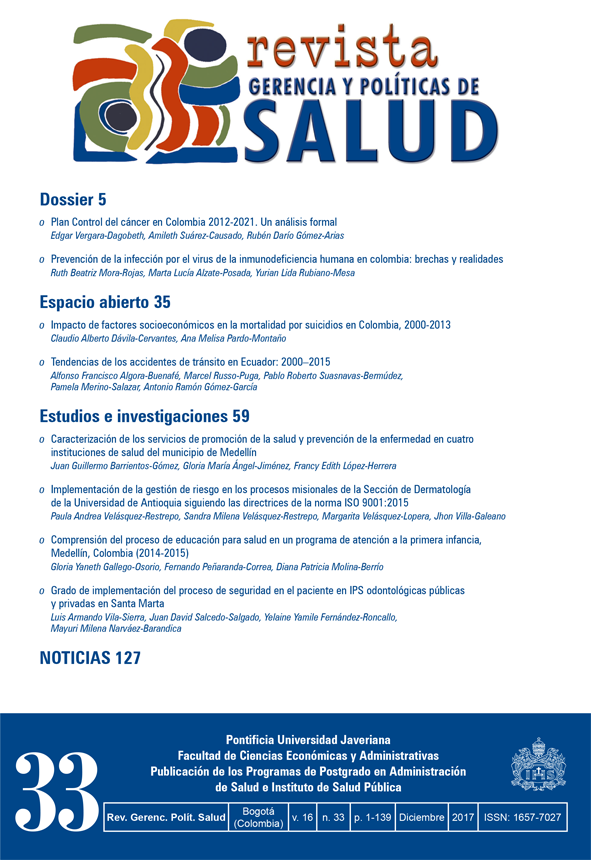Resumen
Introducción: los accidentes de tránsito constituyen un problema prioritario en salud pública a escala mundial, principalmente en los países de Latinoamérica, por ser una de las primeras causas de mortalidad en la región. Objetivo: estudiar la evolución y tendencia de los accidentes de tránsito en Ecuador en el periodo del 2000 al 2015. Método: estudio ecológico a partir de fuentes secundarias de información oficiales. Se presentan los resultados de las tasas de mortalidad poblacional por accidentes de tránsito y los índices de motorización, accidentabilidad, lesividad y letalidad, con el objeto de comparar las variaciones temporales en el periodo de estudio. Resultados: la tasa de mortalidad poblacional presentó una tendencia al aumento en el periodo de estudio y correlacionada con los índices de motorización y lesividad (p<0.01). Conclusiones: se requiere un mayor esfuerzo para optimizar las actividades destinadas al cumplimiento de las normas legales de tránsito y educación vial para la población ecuatoriana.
2. World Health Organization. Global status re- port on road safety 2015. Ginebra: WHO. Di- sponible en: http://apps.who.int/iris/bitstre am/10665/189242/1/9789241565066_eng.pdf?ua=1
3. Mayou R, Bryant B. Consequences of road traffic accidents for different types of road user. Injury.
2003;34:197-202.
4 Ameratunga S, Hijar M, Norton R. Road-traffic injuries: confronting disparities to address a glob- al-health problem. Lancet.2006;367:1533-40.
5. World Health Organization. Ten statistical high- lights in global public health: Part 1. Ginebra: WHO. Disponible en: http://www.who.int/whosis/ whostat2006_10highlights.pdf
6. Bhalla K, Sharaz S, Abraham J, Bartels D, Pon Hsiu Y. Road injuries in 18 countries. Departament of Global Health and Population. Har vard School of Public Health. Disponible en: http://pubdocs. worldbank.org/en/51961434469793140/Road-Safe- ty-Injuries-18Countries-HarvardReport.pdf
7. Miranda JJ, López Rivera LA, Quistberg DA, Rosales Mayor E, Gianella C, et al. Epidemiology of road traf- fic incidents in Peru 1973-2008: Incidence, Mortality, and Fatality. PLoS ONE. 2014;9(6):e99662.
8. Brazinova A, Majdan M. Road traffic mortality in the Slovak Republic in 1996-2014. Traffic Inj Prev.
2016;17(7):692-8.
9. Hamad K. Road traffic accidents trends in Sharjah, United Arab Emirates during 2001-2014. Interna- tional Journal of Vehicle Safety. 2016;9(1):24-38.
10. Instituto Nacional de Estadísticas y Censos. Resulta- dos, Ecuador. Disponible en: http://www.ecuadoren- cifras.gob.ec//resultados
11. Agencia Nacional de Tránsito. Estadísticas de trans- porte terrestre y seguridad vial, Ecuador. Disponible en: http://www.ant.gob.ec/index.php/noticias/esta- disticas#.V4I6YFcWUvP
12. Sociedad Española de Epidemiología. 2007. Indicado- res de morbilidad y mortalidad de lesión por accidente de tráfico. España. Disponible en: http://www.msssi. gob.es/profesionales/saludPublica/prevPromocion/ Lesiones/docs/INDICADORES.pdf
13. Agencia Nacional de Tránsito de Ecuador. Regla- mento a Ley de Transporte Terrestre Transito y Seguridad Vial. Registro Oficial Suplemento N.° 731, 25 de junio del 2012.
14. Mirzaei M, Mirzadeh M, Shogaei Far H, Mirzaei M Trends in road traffic deaths in Yazd, Iran, 2004-
2010. Arch Trauma Res. 2016; 5(2):e29266.
15. Bodalal Z, Bendardaf R, Ambarek M. A Study of a decade of road traffic accidents in Benghazi-Libya:
2001 to 2010. PLoS One. 2012;7(7): e40454.
16. Bacchieri G, Barros AJ. Traffic accidents in Brazil from 1998 to 2010: many changes and few effects. Revista de Saúde Pública. 2011;45(5):949-63.
17. Agencia Nacional de Tránsito de Ecuador. Ley Orgánica de Transporte Terrestre, Tránsito y Se- guridad Vial. Registro Oficial Suplemento N.° 398, 7 de agosto del 2008.
18. Agencia Nacional de Tránsito de Ecuador. Ley Orgá- nica de Transporte Terrestre, Tránsito y Seguridad Vial. Registro Oficial Suplemento N.° 415, 29 de marzo del 2011.
19. Ecuador. Código Orgánico Integral Penal, COIP. Regis- tro Oficial Suplemento N.º 180, 10 de febrero del 2014.
20. Xie SH, Wu YS, Liu XJ, Fu YB, Li SS, Ma HW, et al. Mortality from road traffic accidents in a rapidly urbanizing Chinese city: A 20-year analysis in Shen- zhen, 1994-2013. Traffic Inj Prev. 2016;17(1):39-43.
21. Bastos JT, Shen Y, Hermans E, Brijs T, Wets G, Ferraz AC. Traffic fatality indicators in Brazil: State diagnosis based on data envelopment analysis research. Accid Anal Prev. 2015;81:61-73.
22. Wang CW, Chan CL. Estimated trends and patterns of road traffic fatalities in China, 2002-2012. Traffic Inj Prev. 2016; 17(2):164-9.
23. Restrepo Morales JA, Medina Hurtado S, Vallejo Mesa J. Pérdidas económicas para las compañías aseguradoras derivadas de personas lesionadas en accidentes de tránsito: Aplicación de un modelo de pérdidas agregadas. Rev Gerenc Polít Salud. 2016;15(30):80-93.
24. Bambarén C, Chú M. Regulación del transporte y accidentes de tránsito por vehículos motorizados en el Perú. Rev Med Hered. 2013;24:305-10.
25. Chia L, Humani S. Accidentes de tránsito en el Perú: ¿Casualidad o causalidad? Cuadernos de Infraes- tructura e Inclusión Social. 2010;1(3).
La revista Gerencia y Políticas de Salud se encuentra registrada bajo la licencia Creative Commons Reconocimiento 4.0 Internacional. Por lo tanto, esta obra se puede reproducir, distribuir y comunicar públicamente en formato digital, siempre que se reconozca el nombre de los autores y a la Pontificia Universidad Javeriana. Se permite citar, adaptar, transformar, autoarchivar, republicar y crear a partir del material, para cualquier finalidad (incluso comercial), siempre que se reconozca adecuadamente la autoría, se proporcione un enlace a la obra original y se indique si se han realizado cambios. La Pontificia Universidad Javeriana no retiene los derechos sobre las obras publicadas y los contenidos son responsabilidad exclusiva de los autores, quienes conservan sus derechos morales, intelectuales, de privacidad y publicidad.
El aval sobre la intervención de la obra (revisión, corrección de estilo, traducción, diagramación) y su posterior divulgación se otorga mediante una licencia de uso y no a través de una cesión de derechos, lo que representa que la revista y la Pontificia Universidad Javeriana se eximen de cualquier responsabilidad que se pueda derivar de una mala práctica ética por parte de los autores. En consecuencia de la protección brindada por la licencia de uso, la revista no se encuentra en la obligación de publicar retractaciones o modificar la información ya publicada, a no ser que la errata surja del proceso de gestión editorial. La publicación de contenidos en esta revista no representa regalías para los contribuyentes.


